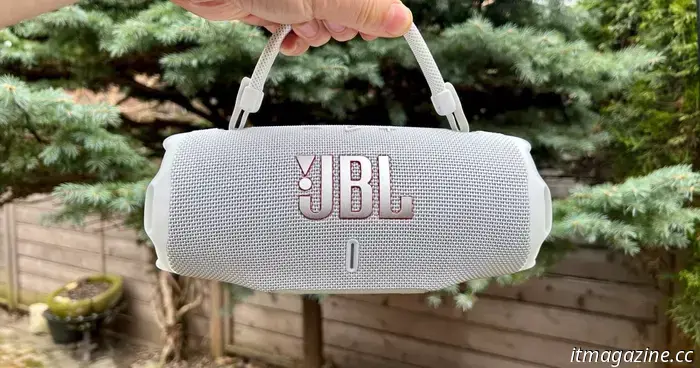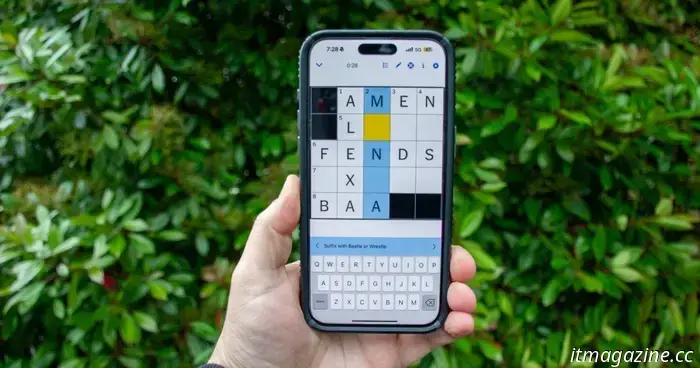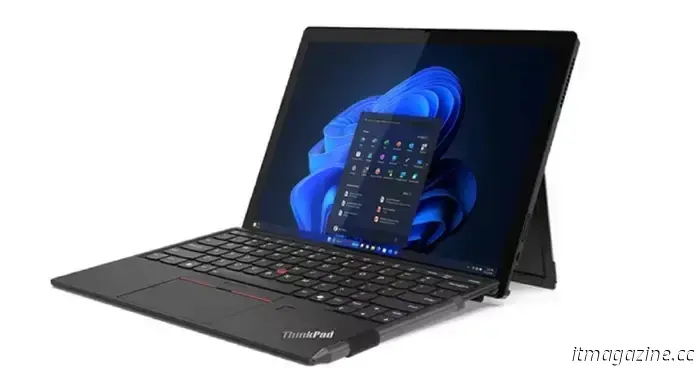
JBL Charge 6 review: How a straightforward strap makes it the ideal portable speaker
**JBL Charge 6**
**MSRP:** $200.00
“More powerful and portable than ever, the Charge 6 is an excellent companion for music lovers.”
**Pros:**
- Sturdy and waterproof
- Powerful for its dimensions
- Handy multipurpose strap
- Outstanding battery life
- USB Audio capability
**Cons:**
- Lacks speakerphone functionality
- No auxiliary input
- High frequencies are overly pronounced
JBL's Charge line of portable Bluetooth speakers has consistently been a top choice for those seeking powerful music on the go. It's clear why; with its durable construction, a large battery that can also charge other devices, and ample volume for a midsize pool party, the Charge is hard to surpass. With the release of the Charge 6, it becomes an even more enticing option, albeit perhaps not for the expected reasons.
**Understanding the Features**
The Charge 6, at first glance, appears unchanged from its predecessor, the JBL Charge 5. It retains the same cylindrical design, rugged woven fabric covering, and prominent JBL logo. It also weighs the same at 2.1 pounds.
However, subtle differences make a significant impact. The Charge 6 is now buoyant and has improved waterproofing (IP68 vs. IP67) along with added drop resistance. The base has been redesigned for better stability on flat surfaces—unlike the Charge 5, which would easily roll over—and the rubberized ends protecting the two passive radiators now have four “legs” rather than three. Furthermore, JBL has separated the controls for power, Bluetooth, and Auracast from those for play/pause and volume, improving accessibility to the most commonly used buttons.
The most notable enhancement is undoubtedly the included strap, which serves as both a wrist strap and a carry handle, transforming the experience of transporting the speaker. Smaller speakers, like the JBL Flip 7 or Beats Pill, can do without a handle, but the Charge 6, at just over two pounds, can be quite cumbersome.
In contrast, many similarly sized speakers provide no carrying assistance. The older Charge 5 lacks any carrying accessories or designated attachment points for one. The UE Everboom has a small accessory loop for a carabiner, while the Monster DNA Max has a wrist strap that doesn't match the comfort offered by the Charge 6’s strap.
Although it may seem trivial, I now find it easy to carry the Charge 6 around the house, while the Charge 5 often remained stationary.
Unfortunately, the Charge 6 does not include a microphone for speakerphone use, and while it can connect to external digital sources through its USB-C port, there is no auxiliary input for analog connections.
**JBL Charge 6 Specifications:**
- **Price:** $200
- **Size:** 9 x 3.9 x 3.7 inches
- **Weight:** 2.11 pounds
- **Power:** 45 watts (peak)
- **Battery Life:** Up to 28 hours
- **Water/Dust Resistance:** IP68
- **Charging:** USB-C
- **Inputs:** USB-C for lossless digital audio
- **Connectivity:** Bluetooth 5.4 (SBC/AAC)
- **Stereo/Mono:** Mono
- **Stereo Pairing/Audio Sharing:** Yes/Yes
**Enhanced Sound Quality**
As mentioned, Charge speakers have long been an excellent choice for gatherings, particularly outdoors, due to their impressive power relative to size. The Charge 6 maintains this standard.
JBL claims the Charge 6 has a slightly higher maximum output than the Charge 5 (45 vs. 40 watts), with the most noticeable improvement being the addition of EQ presets and a more advanced equalizer in the JBL Portables app. These features, combined with a new AI Sound algorithm, allow the Charge 6 to deliver deeper bass and clearer highs with reduced distortion compared to its predecessor.
Nonetheless, the new tuning tends to accentuate the highest frequencies, especially noticeable with the Energetic preset. While I am particularly sensitive to such issues, those who find it bothersome can easily adjust the highs using the custom EQ feature in the app.
**USB Audio Feature**
I’m uncertain how essential USB Audio is for a portable speaker like the Charge 6, but having the option is appreciated. When connected to a compatible USB-C port on a computer or smartphone (you must hold the play button while plugging it in), the Charge 6 can process lossless digital audio, providing a smoother sound compared to Bluetooth.
Most users may not experience a dramatic improvement, and if you lack a lossless music source like Apple Music or Qobuz, you won't gain any advantages. However, the excessive emphasis on high frequencies noted via Bluetooth diminishes significantly when using USB Audio. For critical listening, you might notice enhanced detail, particularly in the midrange.
**Expanded Audio Sharing**
The Charge 6,







Other articles
 NYT Mini Crossword today: solutions for Wednesday, April 16
The NYT Mini crossword may be significantly smaller than a standard crossword, but it's still quite challenging. If you're having trouble with today's puzzle, we have the solutions for you.
NYT Mini Crossword today: solutions for Wednesday, April 16
The NYT Mini crossword may be significantly smaller than a standard crossword, but it's still quite challenging. If you're having trouble with today's puzzle, we have the solutions for you.
 Enjoy significant savings on the JBL PartyBox Club 120 Bluetooth speaker when you make your purchase today.
The JBL PartyBox Club 120 is currently available for $330, down from its original price of $400. You can take advantage of this great offer at Amazon, Best Buy, and several other retailers.
Enjoy significant savings on the JBL PartyBox Club 120 Bluetooth speaker when you make your purchase today.
The JBL PartyBox Club 120 is currently available for $330, down from its original price of $400. You can take advantage of this great offer at Amazon, Best Buy, and several other retailers.
 Mario Kart World Direct: When and where to tune in
Nintendo is set to hold a brief Direct focused on Mario Kart World. Here's how you can watch it.
Mario Kart World Direct: When and where to tune in
Nintendo is set to hold a brief Direct focused on Mario Kart World. Here's how you can watch it.
 Lenovo's alternative to the Surface Pro is currently discounted by over $1,000.
The Lenovo ThinkPad X12 Gen 2 Detachable is a 2-in-1 laptop that serves as an alternative to Microsoft’s Surface Pro models. It is currently available with a 45% discount.
Lenovo's alternative to the Surface Pro is currently discounted by over $1,000.
The Lenovo ThinkPad X12 Gen 2 Detachable is a 2-in-1 laptop that serves as an alternative to Microsoft’s Surface Pro models. It is currently available with a 45% discount.
 This strange exoplanet revolves around two stars in an unprecedented manner.
Astronomers have made a peculiar finding: a planet that revolves around two stars at an unusual angle.
This strange exoplanet revolves around two stars in an unprecedented manner.
Astronomers have made a peculiar finding: a planet that revolves around two stars at an unusual angle.
JBL Charge 6 review: How a straightforward strap makes it the ideal portable speaker
JBL’s Charge series of portable speakers has consistently been a popular choice for those seeking powerful sound on the go. The reasons for this popularity are clear. Featuring a durable design, a large battery that doubles as a charger for your other devices, and sufficient volume to energize a mid-sized pool party, the Charge is tough to rival. [...]
